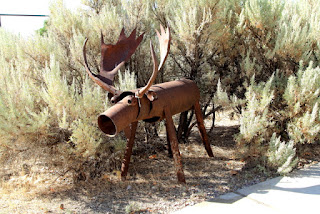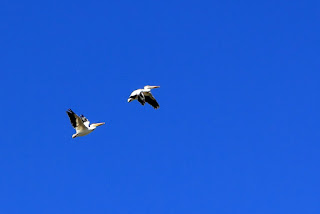The first thing that I noticed at the visitor center was a large statue of Chief Pocatello, and an number of informational displays on the Chief and the Shoshone Indians. Until I read the display information, I did not realized that the Shoshone territory included most of Idaho, northern Utah, norther Colorado, Montana, Wyoming, central Nevada, and part of California. Apparently, the Shoshone Indians traded with the Ute and Comanche tribes in the early 1700s and they were the first tribe in the mountain areas to trade for horses. The Shoshone tribes then introduced horses to all of the Intermountain West tribes including the Nez Perce, Crow, and Blackfeet. In the Shoshone culture, a man's wealth was measured by the number of horses he owned, so When Chief Pocatello died he was buried with 18 of his best horses.
It turns out the parking lot for the Fort Hall replica really is the same parking lot used by the Animal Control Center, which is adjacent to the Pocatello Zoo and located in front of the Bannock County Historical Museum. Admission to the old Fort Hall replica is free; but you can not get to the fort without paying an entrance fee to go through the Bannock County Historical Museum first. (Apparently, the Fort is now part of the County Museum.)
When I walked up to the museum, I noticed a rare horseshoe tree in the front yard and two hungry-looking-animals that had apparently escaped from the zoo that were planning to have the tree for lunch.
The Museum and the old Fort Hall replica were both interesting and the Fort had a very informative movie to watch. Also included onsite was a recreated 19th century Pocatello townsite.
One of the most unusual museums that I have ever toured is the Museum of Clean, located in the old historic district of Pocatello. The museum is still under renovation with three of the six floors completed or near completion.
The 74,000 square-foot building was originally constructed in 1916, but it was restored, expanded, and upgraded in 2011 to be the ultimate "green" building in terms of "maximum levels of safety, health, environment, and convenience and beauty." Tourist literature states "Because there are only a handful of buildings in the U.S. that come close to equaling it in the aspect of being green and environmentally responsible, it was designed, and we are on track to be a Platinum level LEED (Leadership in Energy and Environmental Design) qualifying building. Utilizing such things as thermo-mass walls, roof water recovery and re-use, and other design elements make the building environmentally friendly."
 |
| 1875-1911 Hand Pump Vacuums |
 |
| World's First Motor-Powered Vacuum (1902) |
 |
| Largest Dust Mop in the World |
As we were touring the museum, we happened to find Don working on one of the displays, so we had a good visit him and then he walked upstairs with us and gave Linda a signed copy of one of his books!
Don's brother is an artist, so throughout the museum are unique art objects made from cleaning products!
Blackfoot claims to be the "Potato Capital of the World" and the City has a unique museum dedicated to potatoes.
According to the Guinness Book of World Records, the museum has on display the "World's Largest Potato Crisp," which measures 25 by 14 inches and weighs 5.4 ounces. The crisp "contains 920 calories, the equivalent of 80 regular Pringle's potato crisps." According to a display sign, potato "crisps" are "made from processed dehydrated potatoes...formed by food processing machines. Potato 'chips' are thinly sliced fresh potatoes crisply fried in vegetable oil." I learn something new every day - now I know the difference between a potato "chip" and a potato "crisp."
Other display signs indicate that the earliest known potatoes were from the high mountains of South America from about 400 B.C.; the average American eats 142.7 pounds of potatoes each year; the potato is the only vegetable that grows in the desert as well as in the mountains above 14,000 feet; and, something that I did not know, "The Spanish discovered the Potato in 1537 and carried some on a return trip to Europe. The vegetable had a hard time being accepted. It was considered to be poisonous or evil in England by the Society for the Prevention of Unwholesome Diets, or S.P.U.D., hence the nickname."
 |
| World's largest potato |
 |
| World's largest potato "crisp" |
And, before leaving the museum, we had to try "potato ice cream!"
Hell's Half Acre is a National Natural Landmark lava flow that erupted about 4,100 years ago, but the name is a little misleading - - the lava flow contains about 162,000 acres! The Lava Trail System starts at rest areas adjacent to both sides of Interstate 15 about 5 miles east of Blackfoot.
When traveling east on Highway 26, just west of Swan Valley, there is a rest area with restrooms, a picnic area, and really nice views of the Snake River.
Everyone passing through Victor on the Teton Scenic Byway (Idaho State Highway 33) needs to stop at the Victor Emporium Old Fashioned Soda Fountain and try one of their "World Famous Huckleberry Shakes!"
Between Victor and Driggs is The Spud Drive-in with their "World Famous Potato" (so large it has to be moved on a flatbed truck) and diagonally across the road is a land conservation area with outdoor interpretative signs.
For those that enjoy nostalgic stops, there is a drive-in root-beer restaurant in Ashton that still has "Car-Hops." However, they do not have trays that hang on the car window like they had in the good old days.
Upper and Lower Mesa Falls is a must stop when traveling on State Route 47 north of Ashton. The visitor center is located near the upper falls, and it is possible to drive between the two parking lots (about one mile) or, if you like to walk, you can follow a trail that follows the river. There are beautiful wild flowers that grow along the trail and the scenery is spectacular!
 |
| Lower Falls |
 |
| Upper Falls |
 |
The Teton Dam site located on the Teton River east of Rexburg is an example of poor engineering by the U.S. Bureau of Reclamation. What was intended to be a reservoir for flood control and irrigation purposes, turned out to be one of the worst dam failures in history.
The reservoir had just filled with water when on June 5, 1976 the earthen dam dike failed. There was about a two hour warning that the dam was going to fail, so most people were evacuated to higher ground. However, the failure still resulted in the deaths of 11 people and about 13,000 cattle.
It cost about $100 million to build the dam and then the federal government paid out over $300 million in claims. Total damages, including infrastructures, was estimated to be $2 billion.
After the flood, the LDS Church donated their Tabernacle to the City of Rexburg, which now houses a flood museum and other artifacts.
For some reason, there are a lot of birds that like to circle the dam site.
 |
| Photographer Unknown |
 |
| Photographer Unknown |
 |
| Photographer Unknown |
There is a beautiful LDS Temple located in Rexburg and BYU Idaho is located directly across the street from the Temple.









































No comments:
Post a Comment